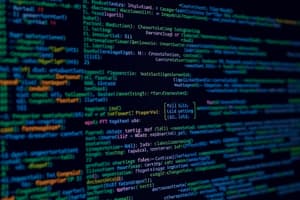Podcast
Questions and Answers
Мәліметтерді және оларды өңдейтін әдістерді бір класста біріктіру қалай аталады?
Мәліметтерді және оларды өңдейтін әдістерді бір класста біріктіру қалай аталады?
- Мұрагерлік
- Инкапсуляция (correct)
- Полиморфизм
- Абстракция
Бағдарлама барысында қателерді өңдеудің ең тиімді тәсілі қайсы?
Бағдарлама барысында қателерді өңдеудің ең тиімді тәсілі қайсы?
- Бағдарламаны тоқтату
- Қатені елемеу
- try...except конструкциясын пайдалану (correct)
- Қатені жасыру
Python-да файлды ашу үшін қай функция қолданылады?
Python-да файлды ашу үшін қай функция қолданылады?
- read()
- write()
- open() (correct)
- file()
Python-да, егер сіз ата-ана класының атрибуттары мен әдістерін жаңа класқа алғыңыз келсе, қай концепцияны пайдаланасыз?
Python-да, егер сіз ата-ана класының атрибуттары мен әдістерін жаңа класқа алғыңыз келсе, қай концепцияны пайдаланасыз?
Төмендегі қайсысы Python-да айнымалыларға мән берудің дұрыс жолы емес?
Төмендегі қайсысы Python-да айнымалыларға мән берудің дұрыс жолы емес?
Python бағдарламалау тілінің негізгі ерекшелігі қандай?
Python бағдарламалау тілінің негізгі ерекшелігі қандай?
Мәліметтердің қай құрылымы өзгермейтін (immutable) реттелген тізбек болып табылады?
Мәліметтердің қай құрылымы өзгермейтін (immutable) реттелген тізбек болып табылады?
Python-да шартты операторлардың дұрыс жазылуы қайсы?
Python-да шартты операторлардың дұрыс жазылуы қайсы?
Python-да қайсы мәлімет типі бүтін сандарды білдіреді?
Python-да қайсы мәлімет типі бүтін сандарды білдіреді?
Python-да қайсысы қайта қолдануға болатын код блогы болып табылады?
Python-да қайсысы қайта қолдануға болатын код блогы болып табылады?
Python-да кластар мен объектілерді анықтау мүмкіндігі қандай парадигмамен байланысты?
Python-да кластар мен объектілерді анықтау мүмкіндігі қандай парадигмамен байланысты?
Python-да for циклі қандай мақсатта қолданылады?
Python-да for циклі қандай мақсатта қолданылады?
Python-да бірнеше қайталанбайтын элементтерді сақтау үшін қолданылатын мәлімет құрылымы қайсы?
Python-да бірнеше қайталанбайтын элементтерді сақтау үшін қолданылатын мәлімет құрылымы қайсы?
Flashcards
Инкапсуляция
Инкапсуляция
Деректер мен әдістерді сыныпта топтастыру.
Мұрагерлік
Мұрагерлік
Бар сыныптардың негізінде жаңа сыныптарды жасау.
Полиморфизм
Полиморфизм
Әр түрлі сыныптардың объектілерін ортақ тип ретінде қарастыру.
Файлмен жұмыс
Файлмен жұмыс
Signup and view all the flashcards
Нұсқалармен тағайындау
Нұсқалармен тағайындау
Signup and view all the flashcards
Python
Python
Signup and view all the flashcards
Тізімдер
Тізімдер
Signup and view all the flashcards
Туплдар
Туплдар
Signup and view all the flashcards
Сөздіктер
Сөздіктер
Signup and view all the flashcards
Шартты операторлар
Шартты операторлар
Signup and view all the flashcards
Функциялар
Функциялар
Signup and view all the flashcards
Модульдер
Модульдер
Signup and view all the flashcards
Объектілік бағдарлау
Объектілік бағдарлау
Signup and view all the flashcards
Study Notes
Introduction to Python
- Python is a high-level, general-purpose programming language.
- Its clear syntax prioritizes readability and reduces code complexity.
- Python's extensive libraries (e.g., NumPy, Pandas, Matplotlib) are popular for data science, machine learning, and scripting.
- Python is an interpreted language; code is executed line by line, unlike compiled languages that translate to machine code first.
- Python is dynamically typed; variable types are not explicitly declared, Python infers them during runtime.
Core Data Structures
- Lists: Ordered, mutable sequences of items, accessed by index.
- Can hold different data types within the same list.
- Methods like
append(),insert(),remove(),pop()allow for dynamic modification.
- Tuples: Ordered, immutable sequences of items.
- Defined using parentheses,
(). - Useful for data integrity and preventing accidental modification.
- Defined using parentheses,
- Dictionaries: Unordered collections of key-value pairs.
- Keys must be unique and immutable (e.g., strings, numbers).
- Values can be any data type.
- Elements are accessed using their keys.
- Sets: Unordered groupings of unique items.
- Useful for set operations like union, intersection, and difference.
Control Flow
- Conditional Statements (if-elif-else): Used to execute blocks of code based on conditions.
- Python uses indentation to define code blocks.
- Loops (for and while): Used for repetitive code execution.
forloops iterate through a sequence (e.g., a list).whileloops repeat as long as a condition holds true.
- Functions: Reusable code blocks.
- Can accept arguments and return values.
- Enhance code organization and reusability.
Data Types
- Integers (int): Whole numbers.
- Floating-point numbers (float): Numbers with decimal points.
- Strings (str): Sequences of characters.
- Booleans (bool): Logical values (
TrueorFalse).
Modules and Libraries
- Python benefits from a broad range of modules and libraries.
- Modules organize code into reusable components.
- Third-party libraries extend Python's capabilities.
- Examples include
math,random, anddatetime(built-in).
Object-Oriented Programming (OOP)
- Python supports OOP, enabling class and object definitions.
- Classes encapsulate data (attributes) and methods (functions) acting on the data.
- Objects are instances of classes.
- OOP Concepts:
- Encapsulation: Grouping data and methods within a class.
- Inheritance: Creating new classes (child classes) from existing classes (parent classes), acquiring their attributes and methods.
- Polymorphism: Allowing objects of diverse classes to be managed as objects of a common type.
Input/Output (I/O)
- Python facilitates interaction with files and users.
- Reading and writing files (text, binary).
- Receiving user input (from the console).
- Displaying output to the console.
Exception Handling
- Python allows for graceful error handling.
try...exceptblocks catch and handle exceptions (errors) during execution, preventing program crashes.
File Handling
- Python provides file handling methods (read, write, append).
- The
open()function is used to open a file. - Different file opening modes exist.
- The
Pythonic Code
- Python promotes clear and expressive code.
- Making effective use of built-in functions and data structures.
- Prioritizing concise, readable code over verbose alternatives.
Variable Assignment
- Python allows flexible variable assignments.
- Direct assignments.
- Compound assignments (e.g.,
+=).
Studying That Suits You
Use AI to generate personalized quizzes and flashcards to suit your learning preferences.




